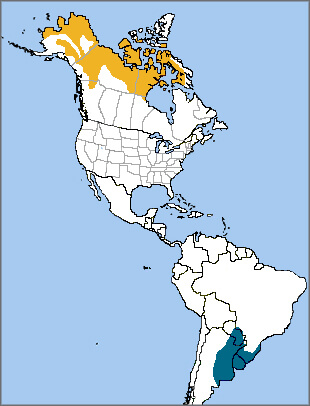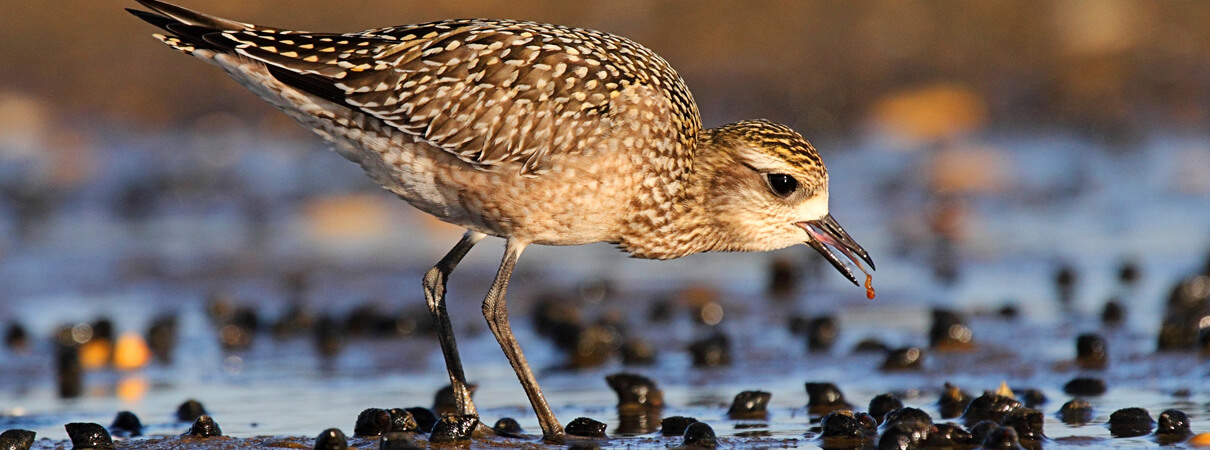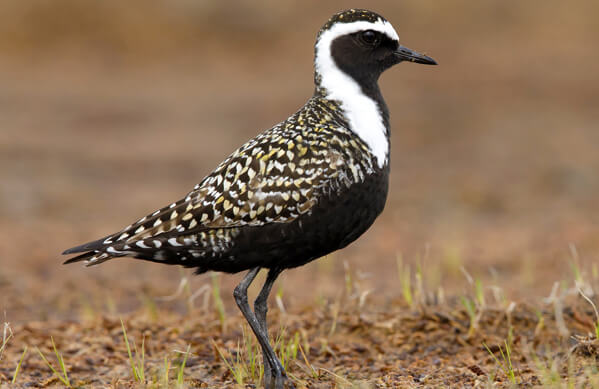 The American Golden-Plover is made for life on the wing, with an elegant, elongated shape set off by eye-catching breeding plumage of black and white with a gold-spangled back. Like other birds that fly long distances, from the Barn Swallow to the Swallow-tailed Kite, it has long, pointed wings. Considered one of the fastest-flying shorebirds, this plover is able to reach speeds of up to 60 miles per hour.
The American Golden-Plover is made for life on the wing, with an elegant, elongated shape set off by eye-catching breeding plumage of black and white with a gold-spangled back. Like other birds that fly long distances, from the Barn Swallow to the Swallow-tailed Kite, it has long, pointed wings. Considered one of the fastest-flying shorebirds, this plover is able to reach speeds of up to 60 miles per hour.
Amazing Annual Journey
The American Golden-Plover flies up to 20,000 miles each year as it migrates, following a circular route that takes it from breeding grounds on the Arctic tundra of northern Canada and Alaska to the grasslands of southern South America and back again. This astounding migration includes a nonstop flight of 3,000 to 3,500 miles over the Atlantic Ocean as these birds move southward in the fall. That stretch alone is a distance greater than the span of the United States, coast to coast.
While migrating, the American Golden-Plover forms large, noisy flocks. In the spring, groups make frequent pit stops to rest and refuel in a variety of habitats, including native prairies, farm fields, mudflats, shorelines, and estuaries.
The American Golden-Plover shares its Arctic breeding grounds with a wide variety of other migratory shorebird species, including the Red Knot, Sanderling, and Dunlin.
Land-Lubbing Shorebird
Like the Mountain Plover and Buff-breasted Sandpiper, the American Golden-Plover prefers grasslands to shorelines, and is often found far from water. In these open spaces, it feeds on insects, seeds, and berries, the latter in particular while packing on fat prior to its long migration. It forages in the same "stop and start" style as other plovers, such as the Wilson's Plover, walking or running a few steps, pausing, then moving forward again, pecking at the ground whenever it spies something edible.
With a trained ear, a birder can identify plovers without even seeing them. Try your hand at comparing the distinctive calls of three plover species, starting with the American Golden-Plover:
(Audio of American Golden-Plover by Frank Lambert XC356253, accessible at www.xeno-canto.org/356253; Audio of Black-bellied Plover by Paul Marvin XC460730, accessible at www.xeno-canto.org/460730; Audio of Killdeer by Frank Lambert XC408273, accessible at www.xeno-canto.org/408273)
Speedy Breeders
As speedy in their nesting cycle as in their epic migrations, American Golden-Plovers get right to work as soon as they arrive on the Arctic tundra each spring. They regularly return to the same sites each year, forming loose colonies. Males are highly territorial, establishing and defending a territory with displays, vocalizations, and confrontations with intruders.
The male selects a nest site, then makes a shallow scrape on the ground, which he lines with moss and dry grasses. The female lays three or four eggs there, placed in a closely packed circle to help keep them warm. Males incubate the eggs during the day, while females take the night shift. The precocial chicks hatch covered in down, and can walk and feed themselves shortly after emerging from their eggs.
Similar to other ground-nesting shorebirds such as the Black-necked Stilt, American Golden-Plovers use dramatic, noisy distraction displays to divert potential nest predators. These displays include the well-known "broken wing" behavior also seen in Killdeer, where the bird flops along the ground while dragging one or both wings to lead intruders away from the nest site.
Adult American Golden-Plovers finish nesting and depart their Arctic breeding grounds by early summer; juveniles linger until late summer or fall. Some adults actually arrive on the wintering grounds before the last juveniles have left the Arctic!

American Golden-Plover in winter plumage, Steve Byland, Shutterstock
Year-round Conservation
The American Golden-Plover was nearly wiped out in the 19th century by market hunting; numbers have partially rebounded since this and many other species were protected by the Migratory Bird Treaty Act and other legislation. These days, one of the greatest threats to this species is habitat loss on its South American wintering grounds. Climate change is also having a significant impact on this plover's Arctic breeding grounds.
In recent years, hundreds of wind turbines have been built along traditional American Golden-Plover migration routes in the Midwest, vastly increasing collision risks. Pesticides are another danger, especially since American Golden-Plovers frequently forage in agricultural fields and stubble.
Through its BirdScapes approach, ABC is working to conserve important stopover, breeding, and wintering sites for migratory birds such as the American Golden-Plover. ABC's Pesticides and Collisions programs also offer solutions to these ongoing issues, and our Policy team continues to fight to preserve the integrity of important conservation laws such as the Endangered Species Act and Migratory Bird Treaty Act.
Donate to support ABC's conservation mission!



















































